The WTR Serra do Mar, the stage that closes the WTR trail running and mountain bike competition calendar, is considered one of the most emblematic. Held in Vale das Videiras, in Petrópolis (RJ), the event offers exclusive experiences praised by all athletes, and courses that pass through farms, trails marked around preserved areas and rare vegetation, in addition to inspiring views of the region’s mountains.
In this article, we showcase all the experiences of the WTR Serra do Mar that provide runners with a transformative immersion in nature. You will also have access to interviews with athletes and coaches about physical and mental preparation for the races and the necessary equipment, as well as learn about the social and environmental practices adopted by WTR to preserve the environment and involve the local population.
Inside WTR Serra do Mar
When it happens: annually, in November
Modalities: trail running and mountain bike
Trail running races: Short (8km), Mid (16km), Full (32km) and Ultra (60km)
WTR Ranking Score: 10,000 points
WTR (World Trail Races), the largest mountain sports league in Brazil and a reference in Latin America, began in 2014. The first competition was held in Arraial do Cabo, a city located in the Região dos Lagos, in Rio de Janeiro, home to paradisiacal beaches.
Three years later, in 2017, WTR Serra do Mar was created, aiming to hold a mountain event that would bring trail runners a characteristic challenge of the sport: trails on uneven terrain with greater elevation. Vale das Videiras, in Petrópolis, was chosen for its mountain range and the possibility of setting up the WTR Arena with unforgettable experiences.
Closing the WTR competition calendar, the stage is considered one of the most emblematic. During November, around 1,500 trail running and mountain bike athletes gather to celebrate the end of the season and the best of the year in the WTR Ranking.
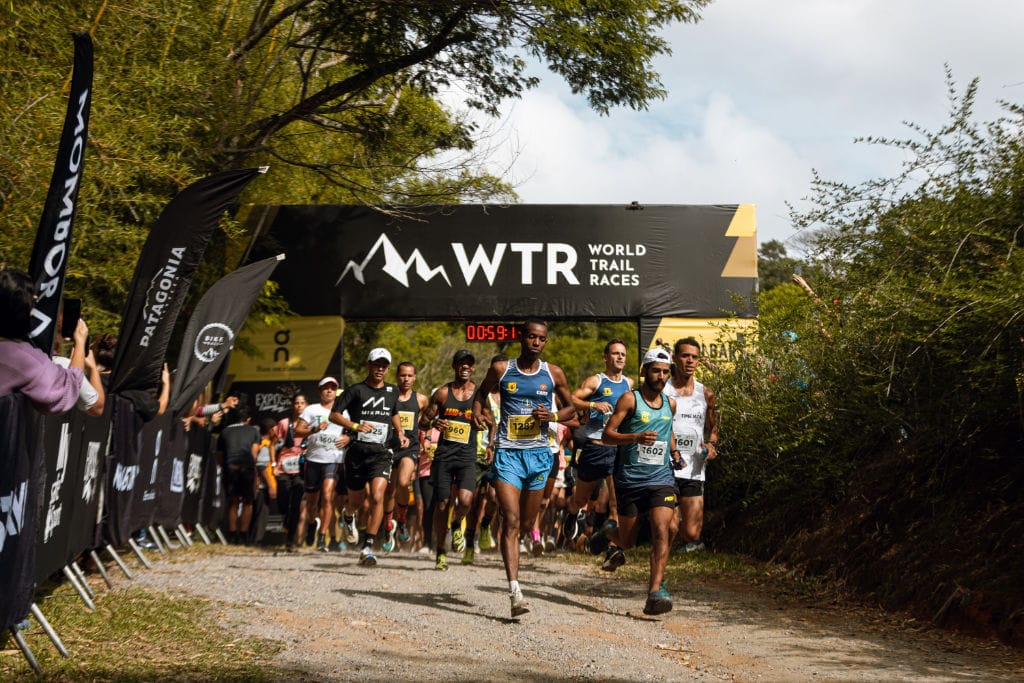
Start of WTR – Photo: Albert Andrade
Competition for all levels
WTR values recognition regardless of distance, rewarding all four courses: 8 km, 16 km, 32 km and 60 km, with equal awards for both the race and the ranking, which attracts trail runners of all levels.
According to Rodrigo Isaac, co-founder and director of WTR, the most disputed category is the Mid, with a 16 km course, 872 m of elevation gain, and a 5% gradient. According to him, while the 8 km race is more “runnable,” with less trail and mostly dirt and asphalt roads, the 16 km race includes a steep and intense climb of approximately 4 km, at Condomínio do Cuca, offering athletes a striking view of the region’s mountain range. “The 16 km course allows athletes to reach one of the highest points of the race, which is also part of the 32 and 60 km categories, as well as experiencing open and closed forests and a single track of approximately 3 km downhill to the asphalt and back to the arena.”
Louise Lima, trail running athlete and Mombora ambassador, took third place in the Mid (16 km) category of WTR Serra do Mar in 2023. She considers the race very beautiful and challenging, due to the elevation. “Besides the climb, which is very steep, the descent also requires preparation and caution as it is winding, with roots and trunks.”
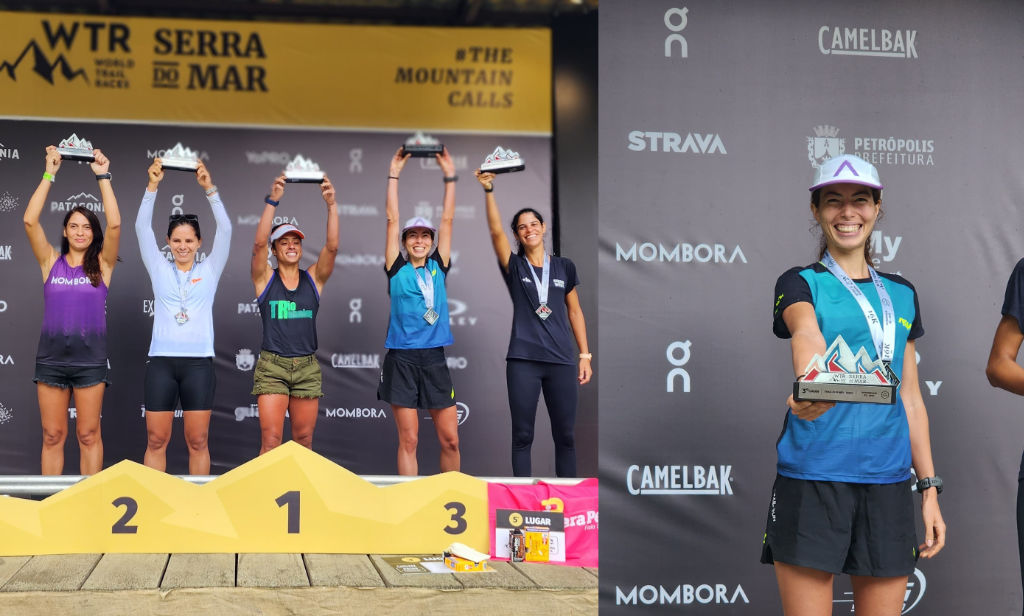
Louise Lima on the WTR Serra do Mar podium
Athlete Rosalia Camargo, The North Face and Gear Tips ambassador, is a fan of WTR Serra do Mar and a regular participant since 2018. “I have a very strong connection with WTR. In the Serra do Mar stage, what catches my attention are precisely the mountains. The climbs are very exhausting and push you to your limit. But the scenery is beautiful. I am passionate about this race!”
Rosalia took third place in the Ultra (60 km) category in 2023, which contributed to her victory in the overall WTR ranking. The athlete also won in 2021, in the 32 km race, and in 2022, when she ran 60 km.

Rosalia Camargo at WTR Serra do Mar races
André Medeiros, CamelBak athlete and coach, has already participated five times in WTR Serra do Mar, three of them in the Full trail running category, one in the Ultra, and, in 2023, in the 50 km mountain bike category.
For him, the course marking is impeccable, in addition to the nature. “WTR Serra do Mar is a welcoming race. The region is pleasant and cozy. I’ve participated in races outside the WTR League where the course was wonderful, but the surroundings were not. There, everything is attractive.”
What makes WTR Serra do Mar a unique experience?
WTR Serra do Mar was designed from the beginning to offer transformative experiences for trail running runners and mountain biking practitioners. In addition to the connection with nature, the event is praised by athletes for the quality of services offered in the arena and along the courses.
Contemplative experiences in nature
Running surrounded by hydrangeas: the trail running competition at WTR Serra do Mar passes through numerous farms in the region. One of them, Fazenda Quilombo, offers a stretch of ascent and descent accompanied by blue hydrangeas from end to end.
Climbing Morro do Cuca: to reach the mountain summit, it is necessary to run the 32 km and 60 km races, but those who choose the 16 km course can see the top from a distance of 2 km, contemplating rare vegetation characteristic of the region.
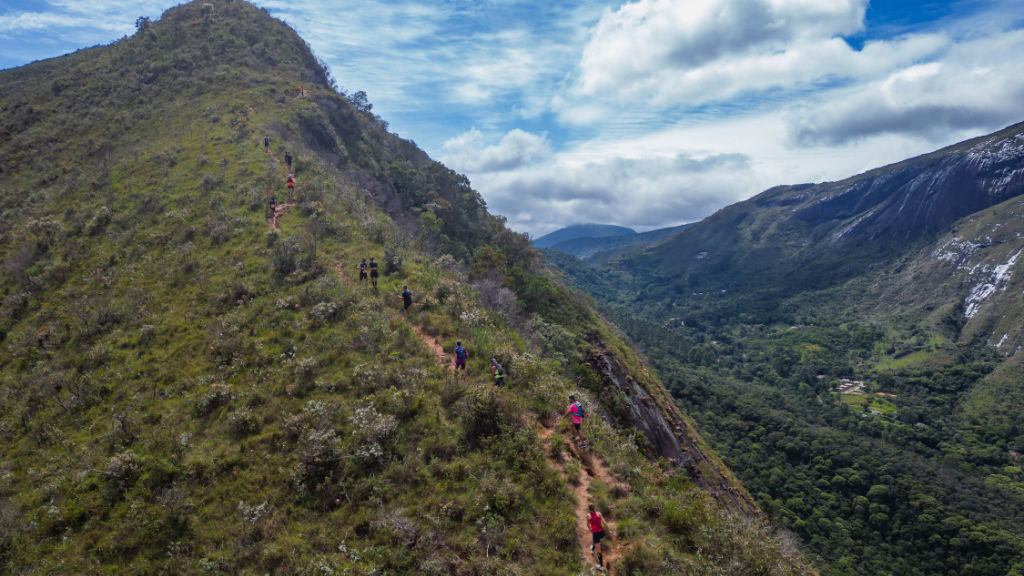
Photo: Felipe Almeida
Appreciating the Quilombo viewpoint: at the beginning of the competition, the Quilombo Viewpoint serves as a warm-up for athletes in the 16, 32 and 60 km races. For participants in the 8 km category, however, it is one of the main challenges.
Spotting Pedra da Índia: located in front of Morro do Cuca, runners of the 16, 32 and 60 km courses can see the shape of an indigenous woman in the preserved area.
Safety and support during the trail running race
Rescue and emergency network
One of the most highlighted positive points by athletes refers to the medical assistance offered in the stage. “We were able to place rescuers (civil firefighters) along the trail, a team specialized in mountain and remote area rescue, with 4×4 vehicles, defibrillators, as well as medical stations, ambulances, and a complete ICU. Our team is also trained to assist athletes. They feel safe running our races, even recommending our ultramarathon,” says Rodrigo Isaac.
Drop bag
With this service, athletes participating in longer races can leave a backpack in the arena with items they will use during the course, carrying less weight throughout the race. “The athlete can, for example, change shoes, shirt, and socks. The service works as support. In the case of the Ultra, where we have high elevation gain in the first half of the race, many athletes usually take trekking poles and leave them in the drop bag so they don’t have to carry them until the end.”
Rosalia Camargo usually changes shoes and socks during long races. “The drop bag structure is excellent for that. In the last race, I even changed clothes. Doing this gives me a feeling of freshness.”
At the location, complete food is also provided, including soup, pasta, as well as medical support.
Easy-access elevation map
Details are present in every runner’s experience. When receiving their bib number, for example, they are surprised with the elevation map printed upside down. Rodrigo Isaac explains that the idea was designed to make it easier for the athlete to lift their shirt and have quick access to the information while running, preparing for the climbs.
Hydration stations
The water refill stations are well distributed along the course. The organization works to minimize waste generation and, therefore, it is essential that you carry a backpack, hydration belt, or bottles, as plastic cups are not provided. WTR also offers collapsible cups for soft drinks and isotonic beverages.
Food stations
The food stations are quite complete, providing all the necessary items for runners to have energy during the race. Among the items are bananas, apples, peanuts, banana candy, sweet popcorn, and paçoca (Brazilian peanut sweet). At the drop bag station, there is also soup and pasta. “We carefully study the race to place food stations near a frontal climb, for example, which will make the runner spend a long time without eating or hydrating. They can consume the items there or take them in their backpacks.”
WTR Serra do Mar Arena: a celebration for everyone
The experiences offered at the arena make WTR Serra do Mar an event for the whole family. In addition to food trucks, which also include vegetarian options, participants can enjoy performances by local bands and entertain the children with trampolines, recreational activities, and the kids’ race itself. For athletes, there are also product tastings, shops with equipment at promotional prices, and a free space for post-competition relaxation.
The festive atmosphere provided by the structure and the gathering with other athletes is highlighted by Rosalia Camargo. “I really enjoy the post-race moment. The gastronomy part is very good, and the experience of meeting all my friends in the arena is wonderful. The energy is great!”
ITRA and UTMB points
In addition to the experiences offered in the arena and during the race, runners of the 32 km and 60 km courses receive ITRA and UTMB points, contributing to their race curriculum. “Normally, athletes run two or three races to accumulate the points and thus qualify for a specific race outside Brazil,” says Rodrigo Isaac.
Furthermore, the WTR director adds that the WTR Serra do Mar races also serve as preparation for other international competitions, such as El Cruce, which usually takes place in December.
How to prepare physically for WTR Serra do Mar
Rodrigo Isaac, in addition to being WTR director, is a physical trainer and has trained more than 2,000 athletes, mainly for trail running. His advice for everyone participating in WTR Serra do Mar is to seek a coach for individualized guidance.
“Together, you will study the race, taking into account the elevation, defining the right moments for stronger pushes, recovery, and sections to go uphill walking or running. All this generates muscle fatigue and must be planned. The descents, for example, tend to overload the quadriceps, while the climbs demand more from the calves.”
An important recommendation is to vary the terrain during training: dirt roads, cobblestones, closed and open trails. In the absence of nearby trails, uphill and downhill training should explore asphalt slopes and staircases to prepare the body for different situations. “Each race is a new experience. Sometimes, the athlete runs the same race several times, and in each one, they gain a new experience, such as using a gel at the right moment or pushing harder on a climb. All of these counts. It’s important to have as many experiences as possible to build a repertoire for the race.”
Maximum strength + balance + injury prevention
For Felipe Sequeira, partner and coach at Studio Higher, and participant in three editions of WTR Serra do Mar, those already used to trail running always need to improve their strength capacity and prepare to avoid injuries.
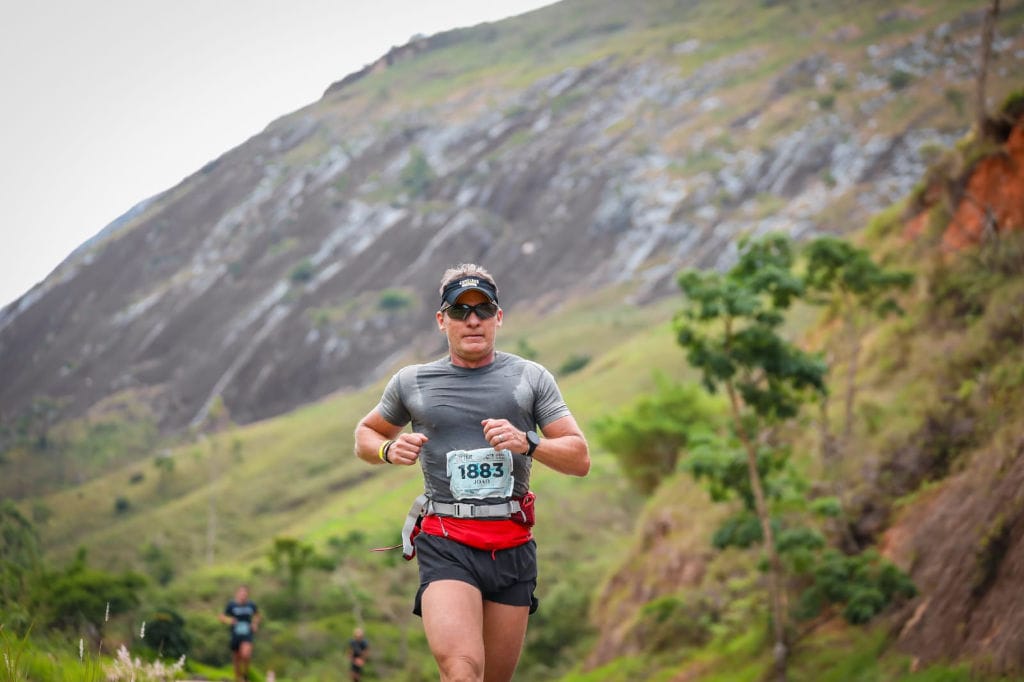
Felipe Sequeira, at WTR Serra do Mar – 16 Km
Felipe’s recommendation is to carry out three types of training:
Plyometrics: plyometric exercises consist of working with jumps. They are fundamental for mountain races, which demand more from the lower muscles both on climbs and descents, overloading quadriceps and knees. Felipe recommends exercises with step jumps and depth jumps, which help improve strength and explosiveness.
Proprioception training: another fundamental workout, according to the coach, is proprioception, which works on balance. Bosu balls, platforms, and inflatable discs are used to perform varied squats, among other exercises. “In addition to ensuring better execution of movement, this type of training helps prevent joint injuries, especially in the ankles. Since trail running terrain is irregular, with rocks and roots, foot placement varies greatly.”
Training aimed at race specifics: in this stage, the coach evaluates whether the race is short or long, as well as the elevation. “As preparation for the WTR Serra do Mar courses, you must train your endurance during a long uphill effort. It’s necessary to accustom your legs to working with great exertion for a prolonged period.”
Felipe’s tip is to train three weeks to a month before the race in places with similar climbs. “It’s no use going up and down a short ramp several times, the ideal is to look for a place with considerable elevation. For those living in Rio de Janeiro, for example, the Mirante do Caeté trail, at Prainha, has a good climb. Repeating it several times is good training.”
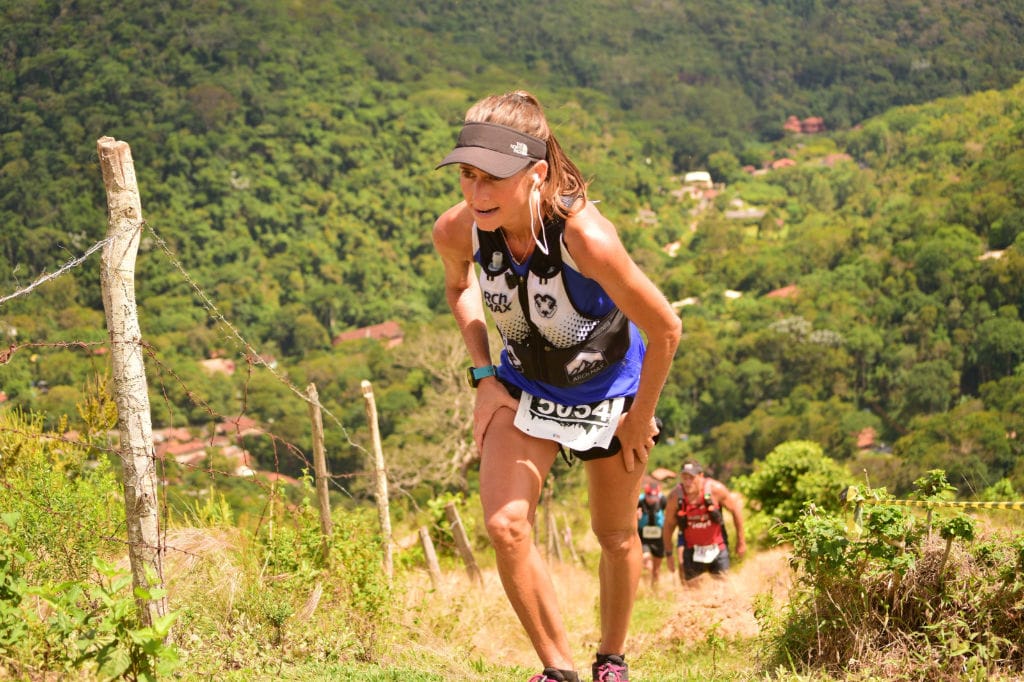
Rosalia Camargo during the climb at WTR Serra do Mar
André Medeiros, CamelBak athlete and coach, points out that the climb at Morro do Cuca becomes even more demanding on very sunny days. Therefore, another recommendation is to train on open trails in sunny weather to acclimate the body, while staying hydrated.
Training with poles
In addition to endurance and strength training, learning to use poles is also a tip to minimize energy expenditure during climbs. “In the 16 km race, due to the 4 km climb, the use of poles is already recommended. The 32 km and 60 km courses, for example, have a VK (vertical kilometer) within the race, with more than 5 km of uphill and 1,000 m of elevation. Knowing how to use poles will allow the athlete to save energy,” recommends Rodrigo Isaac.
The tip is also shared by André Medeiros. “The climb at Morro do Cuca is very tough, and the use of poles is highly recommended, even if you don’t use them throughout the entire race. It’s definitely worth it.”
Nutritional supplementation
Supplements are allies of trail runners as they provide energy boosts and are practical to consume both during training and races. Athlete Louise Lima mainly recommends carbohydrate supplementation. “I use Carbo powder – mango with passion fruit, by Mombora, before or during the race, and sachets throughout the race. These supplements are very close to natural food, which makes digestion easier.”
In the 2024 edition, the Mombora Station, set up in the WTR Serra do Mar arena, will offer gel tastings and exclusive discounts for participants.
Mental preparation for the challenges of WTR Serra do Mar
Felipe Sequeira, partner and coach at Studio Higher
Before the races, it is natural for athletes to feel some anxiety and tension, but there are ways to ease them. One is to study the course in advance to know the route, terrain, location of climbs and descents, and hydration stations. A technique used by coach Felipe Sequeira to reassure his students is to take them, when possible, to preview the course before the race. This way, they become familiar with the route.
“I ran the 16 km WTR Serra do Mar course twice. In the first, I remember struggling a bit with the climb because I wasn’t well-prepared. In the second, since I already knew the race, I knew what to do to climb more calmly,” says Felipe.
The coach’s second piece of advice is to seek information from other people to prepare for the challenges. “I participated in a long race outside the WTR circuit that required a windbreaker, but listed an anorak as optional. Talking to two people, they recommended I take it. I was convinced, and the item saved my life. Due to heavy rain and cold, I saw many people drop out of the race,” says Felipe.
Therefore, the third tip is to make sure you have the recommended equipment so you can finish the race in a healthy, enjoyable, and safe way.
Meditation and psychological support
Athlete Louise Lima’s mental health care involves the support of sports psychologists and meditation. “Even being physically prepared, with supplementation in place, the mental part can sometimes limit us. From the moment I was able to dedicate time to meditation, breathing, and calming down, I realized how much the practice helps me daily and in sports, by managing anxiety that, in excess, can impair race performance.”

Louise Lima
Recommended gear for WTR Serra do Mar
Backpack and hydration systems
As we mentioned earlier, the hydration stations at WTR Serra do Mar are for refilling. Therefore, it is mandatory to carry a hydration system during the courses, such as a backpack, squeeze bottle, or belt, with a minimum capacity of 500 ml. Athlete Louise Lima used a 1-liter hydration backpack to complete the 16 km race and didn’t need many stops for refills.
CamelBak is a reference in hydration, being the pioneer of the reservoir model integrated into its backpacks. The brand also offers backpack and belt models with compartments for bottles and gels.
For those running the 8 km, 16 km, and 32 km races, a hydration backpack is usually sufficient. For the ultra (60 km), more space is needed to carry the mandatory items: a headlamp, which must be turned on after 6 p.m.; a thermal blanket to keep the body warm in case of accidents until rescue arrives; and a whistle.
André Medeiros, CamelBak athlete, has been dedicating himself to longer races, so he uses backpacks with larger volumes, such as the Apex PRO and the Zephyr Pro Vest hydration backpack. “These models are functional because I need to carry more gear, with mandatory items.”
Since 2016, the athlete has been using the so-called soft flasks, popular among athletes. “With them, you have a real sense of how much liquid you are carrying, unlike the reservoir that stays hidden in the backpack.” In shorter races, such as the 32 km, André recommends 4- and 6-liter backpacks.
CamelBak models are recommended by athletes and vary according to volume and gender. Check out the article about the Apex PRO here on the Gear Tips blog.
With vast experience in mountain running and accustomed to longer races (32 and 60 km), Rosalia Camargo says she always carries an 8-liter backpack with two 500 ml bottles, a thermal blanket, a whistle, and a windbreaker, regardless of whether they are mandatory or not. “I also usually take gloves because the weather can change in the mountains during long races, which last 6 to 7 hours.”
The backpack used by the athlete is the Summit Series Run Race Day Vest 8, from The North Face. “Although it has 8 liters, the stretch fabric fits snugly on the body. The two bottles go in the front, plus there’s a zippered pocket for small items and other easy-access front pockets for cell phone, gel, and food. The back compartment, without a zipper, allows me to ask another athlete to store a fleece I used at the start, for example. During the race, I don’t need to take the backpack off to grab anything.”
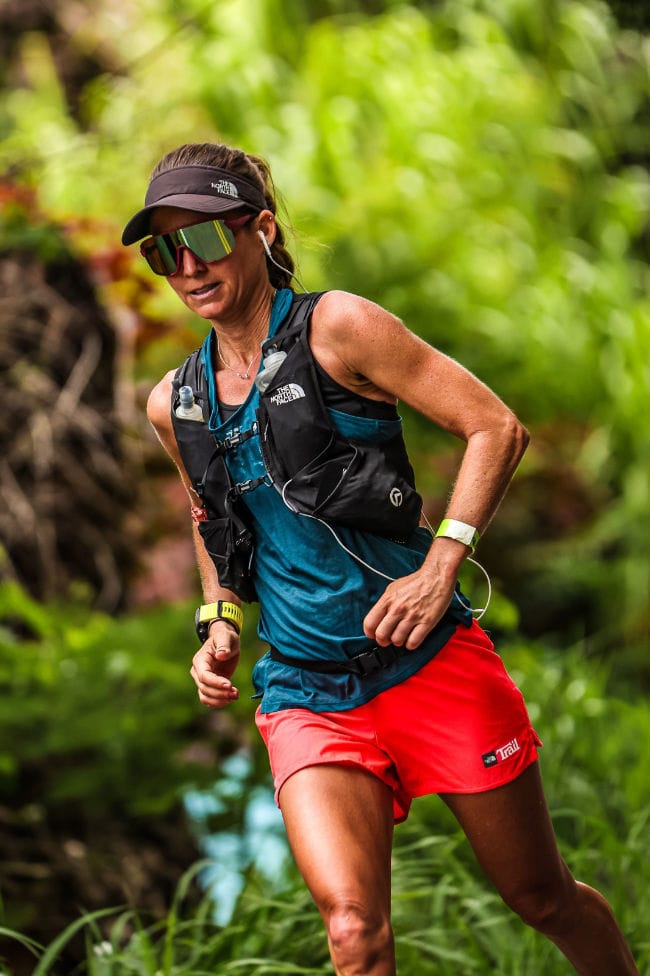
Rosalia Camargo with The North Face backpack
Trail running shoes
For all courses, low- or medium-grip shoes are recommended. Louise chose an intermediate-grip model. “I knew I would go through a lot of forest area and could slip on the steep downhill. I chose a slightly more aggressive model, considering the type of terrain of the race.”
Rosalia recommends using shoes with strong traction since it is a more technical race with some slippery sections. “Having good shoes for the downhill makes all the difference.”
On, which during the 2024 edition of WTR Serra do Mar will offer test drives of its models, has an exclusive line of trail running shoes.
Clothing
Rosalia Camargo recommends, regardless of the course length, the Summit line from The North Face. “These are performance-oriented pieces. The windbreaker, for example, is efficient and takes up little space in the backpack because it is very compact.”
Windbreaker: although the race takes place in November, when temperatures are higher, the Vale das Videiras region has microclimates, which means you may start the race under the sun and, as you climb the mountain, encounter much colder weather. Therefore, it is important to carry a windbreaker in your backpack. Rosalia recommends the women’s Cyclone 3 Jacket, from The North Face. In addition to the windbreaker, it is advisable to take an anorak in case of rain forecast.
Shorts: athletes Louise Lima and Rosalia Camargo recommend models with pockets for carrying gels and other essentials. The model used by Rosalia is the Women’s Summit Pacesetter Run Shorts TNF, from The North Face.
At the WTR Serra do Mar 2024 arena, participants will be able to visit The North Face store, which will offer promotional prices.
Other recommended items:
- Sunscreen and cap to protect your face from the sun
- Repellent
- Poles
- Whistle: recommended for the Mid and Full categories (16 and 32 km) and mandatory in the ULTRA (60 km), the whistle is necessary to signal where you are or that you need help.
- First aid kit: despite the complete emergency support network offered by the event, it is important to carry essential items.
Sustainability: preservation actions practiced by WTR
Nature is the main setting for trail running races, therefore, preserving it is the guarantee of new transformative experiences. WTR is aware of this and, in addition to promoting excellence in the arena and along the courses, the company maintains important work aimed at preserving the local area, reducing environmental impact, and raising participant awareness.
Waste management station
The production of a large-scale event generates a huge amount of waste. To reduce environmental impact, WTR maintains a partnership with a sustainability consulting company that supports the organization from setup day. All generated waste is separated and directed to proper disposal.
An innovative and impactful experience offered by WTR Serra do Mar is a tent in the arena, run by COMDEP collaborators, a local cooperative, who sort the waste in real time, giving visibility to the initiative. “Our goal with the waste management station is for athletes and event participants to see how this work is done. The initiative is a way to raise awareness about the importance of properly disposing of the waste generated,” says Gabriela Corrêa, WTR brand head.
Another way to draw attention to sustainability is through sponsor actions. In partnership with Heineken, for example, WTR Serra do Mar will gift participants a keychain bottle opener for every 5 long necks discarded at the waste station.
In addition, the organization provides bins throughout the arena for recyclable, organic, and residual waste.
The end of plastic cups
A classic of races, especially road races, are the water cups offered for athlete hydration. In WTR races, a sustainable idea to eliminate plastics was to include silicone cups in the participant kit, accompanied by communication alerting about the mandatory use for hydration. “We are even studying an alternative for runners to discard these cups after the event, in case they don’t want to accumulate them at home.”
Local preservation and restoration
Rodrigo Isaac, co-founder and director of WTR
WTR maintains a partnership with State Institute for the Environment (Instituto Estadual do Ambiente -INEA), promoting several actions for local conservation. One of them, aligned with Principle 2 of Leave no Trace – Travel and camp on durable surfaces –, is marking athlete passages with ribbons so they avoid the rare vegetation in the region.
INEA is also responsible for granting all necessary documentation for WTR Serra do Mar to take place consciously, reducing environmental impacts in the region. “We share all race routes so they can check that we are not passing through any critical areas, which may vary each year due to deforestation and erosion. INEA also evaluates our signage proposal to mitigate impacts, in addition to providing suggestions for improvements,” says Gabriela.
In addition, together with the Reserva Biológica Estadual (State Biological Reserve) de Araras, an INEA conservation unit, WTR Serra do Mar carries out seedling planting as a counterpart for the local community, among other initiatives. “We donated a vegetation mat to reforest the degraded area, as well as planting materials and seedlings for handling and cultivation by forest rangers,” adds Rodrigo Isaac.
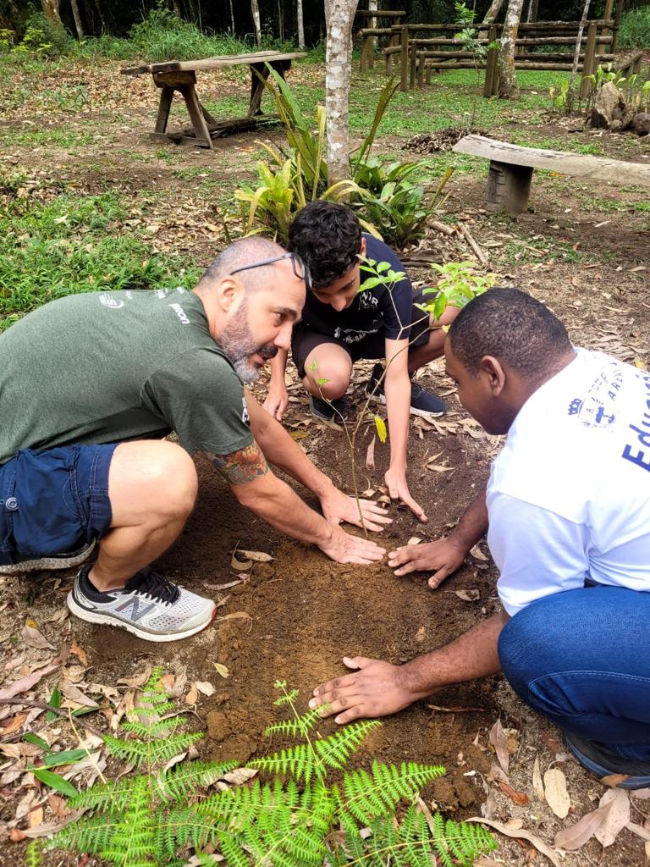
Rodrigo Isaac
Transforming banners into WTR accessories
Since 2023, WTR, in partnership with Ciclou, has promoted the upcycling of banners used in its events. Through the hands of small artisans, the material is transformed into backpacks, wallets, and pouches. Another creative idea that has won athletes over. “Some artists customize the products according to the communication details printed on the banners, such as the name of a stage and athletes, for example. It is gratifying to see that WTR event participants can recognize through the initiative that we transform into quality products what would otherwise improperly end up in nature,” celebrates Gabriela.

Photo: Albert Andrade
Social responsibility: WTR Serra do Mar legacies
Every year, WTR Serra do Mar supports a local institution. In 2023, the company collected and donated sports materials provided by athletes. “It’s a way to encourage people to pass on items in good condition that often end up being discarded. We collected between 150 and 200 items. Many products are new or used in excellent condition.” According to Gabriela, the donation was made to children and teenagers participating in an orienteering project.
Training local workforce
All WTR Serra do Mar staff are from Petrópolis. “As Vale das Videiras is small, people come from Petrópolis and Itaipava with a bus provided by WTR so they don’t incur public transport costs. All instructions are given by Rodrigo Isaac who, more than explaining the technical part of the work, shows professionals their importance in the athlete’s journey. We can notice how much they feel belonging when hearing Isaac’s words,” says Gabriela.
The effort and dedication of these professionals are recognized by competitors, who often praise the quality of service and the encouragement staff give during the race. “They are very enthusiastic and support us throughout the course. It’s a great atmosphere,” says athlete Rosalia Camargo.
In addition, holding WTR Serra do Mar in Vale das Videiras helps generate jobs and boost the local economy. “With the event, we fill Videiras, Petrópolis, Itaipava, and Araras. We are also careful never to hold races on holidays, precisely to occupy the region during a period when the circulation of people is lower. It is very rewarding to see our impact in small places like Vale das Videiras,” adds Gabriela.
Where to stay during WTR Serra do Mar
WTR partners with a hotel network, which makes it easier for participants to find accommodation. For the WTR Serra do Mar stage, there are two accommodation options:
- Castelo de Itaipava: by choosing this classic regional hotel, your experience begins even before the race, as the location is a medieval castle with a complete structure and a variety of shops around it. A great option for those spending the weekend in the region.
- Bomtempo II: located in the middle of an extensive conservation area and with a neocolonial-style infrastructure, the hotel offers cozy chalet accommodations for solo travelers or families.
For those who just want to participate in the race without staying in the region, WTR Serra do Mar partners with a group that organizes excursions, with vans, minibuses, and buses, depending on the number of participants.
WTR race calendar
In this article, we present the main characteristics of WTR Serra do Mar, held in Vale das Videiras, in Petrópolis. Although most WTR races are held in Rio de Janeiro (Serra do Mar, Praias Selvagens, Miguel Pereira, Floresta da Tijuca, and Arraial do Cabo), there are also stages in São Paulo (Campos do Jordão) and Minas Gerais (Nova Lima). Check out the WTR race calendar.
The WTR calendar goes far beyond the races and promises a complete experience for everyone present. At the start and finish area of the races, the WTR Arena is a space that transcends sport and offers experiences for the whole family, such as a food hall, partner shops, massages and recovery for athletes, sponsor activations, concerts, and post-race gatherings.
The excellence promoted by WTR – World Trail Races has made it one of the leading outdoor sports leagues in Latin America, bringing together mountain runners and cyclists in a unified calendar and ranking.
Check out the Gear Tips Club partners featured in this article and the exclusive discounts for members:
This post is also available in: Português (Portuguese (Brazil)) Español (Spanish)
